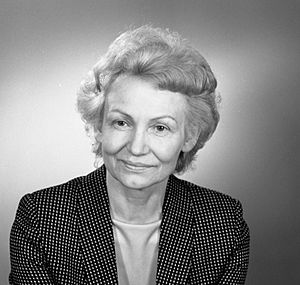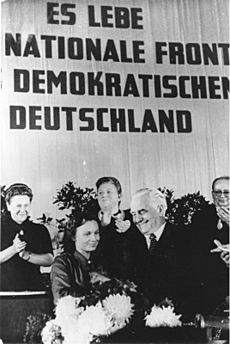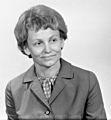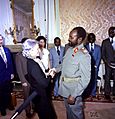Margot Honecker facts for kids
Quick facts for kids
Margot Honecker
|
|
|---|---|

Honecker in 1986
|
|
| First Lady of the German Democratic Republic | |
| In office 29 October 1976 – 18 October 1989 |
|
| President | Erich Honecker |
| Preceded by | Marianne Wiegank |
| Succeeded by | Erika Krenz |
| Minister of National Education | |
| In office 14 November 1963 – 2 November 1989 |
|
| President | Walter Ulbricht Willi Stoph Erich Honecker Egon Krenz |
| Prime Minister | Otto Grotewohl Horst Sindermann Willi Stoph |
| Personal details | |
| Born |
Margot Feist
17 April 1927 Halle (Saale), Province of Saxony, Prussia, Germany |
| Died | 6 May 2016 (aged 89) Santiago, Chile |
| Resting place | Parque del Recuerdo, Santiago |
| Political party | KPD (1945–1946) SED (1946–1990) KPD (1990–2016) |
| Spouse | |
| Children | Sonja Honecker (b. 1952) |
| Parent | Gotthard & Helene Feist |
| Residences | Santiago, Chile |
Margot Honecker (born Margot Feist; 17 April 1927 – 6 May 2016) was a politician from East Germany. She was an important person in the country's Communist government until 1989. From 1963 to 1989, she served as the Minister of National Education. She was married to Erich Honecker, who was the leader of East Germany's ruling party from 1971 to 1989. He was also the country's head of state from 1976 to 1989.
Margot Honecker was known for her strong Communist beliefs. She helped create the "Uniform Socialist Education System" in 1965. This system made military training mandatory in schools. This training prepared students for a possible war with Western countries. She faced accusations of being responsible for the forced adoption of children. These were children of people who were jailed or tried to leave East Germany. She also set up special institutions for children. One of these was a camp at Torgau.
After the Communist government fell in 1990, Honecker and her husband went to the Soviet Union. They wanted to avoid legal issues in Germany. In 1991, they sought safety in the Chilean embassy in Moscow. In 1992, her husband was sent back to Germany. Margot Honecker then moved to Chile. She lived there with her daughter Sonja until her death.
Contents
Early Life and Family Background
Margot Feist was born in Halle on 17 April 1927. Her father, Gotthard Feist, was a shoemaker. Her mother, Helene Feist, worked in a factory. Both of her parents were members of the Communist Party of Germany (KPD). Her father was held in concentration camps in the 1930s. Police searched their home several times.
Margot's mother passed away in 1940 when Margot was 13. After finishing elementary school, Margot joined the Bund Deutscher Mädel. This was a girls' organization of the Nazi Party. Joining this group was required for young people at the time. Her brother, Manfred Feist, later became a leader in the ruling party's Central Committee.
Joining the Communist Party
In 1945, Margot Feist joined the Communist Party of Germany (KPD). In 1946, the KPD merged with another party. This created the Socialist Unity Party of Germany (SED). This party became the ruling party of East Germany. Margot became a member of the SED. She worked as a typist for a trade union in Halle.
In 1946, she also joined the Free German Youth (FDJ). This was the youth group of the ruling party. She quickly moved up in the organization. By 1947, she led the culture and education department. In 1948, she became a secretary for the FDJ's central council. She also became the chairperson of the Ernst Thälmann Pioneer Organisation.
By 1949, Feist was part of East Germany's early parliament. In the same year, at age 22, she was elected to the new People's Chamber. Margot Feist met Erich Honecker at FDJ meetings. He was the chairman of the FDJ. They later married in 1953 and had a daughter, Sonja, in 1952.
Role as Education Minister
In 1963, Margot Honecker became the Minister of National Education. She had been acting in this role before. On 25 February 1965, she introduced a new law. This law made the "uniform socialist education system" standard. It applied to all schools, colleges, and universities in East Germany.
For her work, she received the Order of Karl Marx in 1977. This was the highest award in the country. In 1978, Honecker introduced military lessons for high school students. This included training with weapons. This policy was put in place despite objections from churches and many parents. Her time as Minister lasted until November 1989.
She faced accusations that she was responsible for the forced adoption of children. These were children of people who were jailed or tried to leave East Germany. Critics said she "left a cruel legacy of separated families." Margot Honecker denied these claims. She also created prison-like institutions for children.
In 1990, accusations were made against her as Minister of Education. These included claims that she had arranged arrests for political reasons. She was also accused of separating children from their parents against their will.
Losing Power and Leaving East Germany
During the Peaceful Revolution of 1989, Margot Honecker stayed in office briefly. This was after her husband was removed as party leader in October 1989. However, she was removed from the cabinet on 2 November. On 4 February 1990, she left the Party of Democratic Socialism. This party was the successor to the SED. Her husband had been expelled two months earlier. She later joined a smaller party called the Communist Party of Germany (KPD).
In March 1991, Margot Honecker and her husband flew to Moscow. They wanted to avoid legal issues in Germany. Her husband was diagnosed with cancer there. They lived in a government house. As the Soviet Union began to break apart, they feared being sent back to Germany. In August 1991, the Honeckers sought safety in the Chilean embassy. They stayed there for nearly a year.
The German and Chilean governments discussed their future. On 29 July 1992, Erich Honecker was sent to Berlin for a trial. Margot Honecker did not go with him. Instead, she flew to Santiago, Chile. She joined her daughter Sonja and her family, who had been living in Chile since 1990.
Life in Chile
After 1992, Margot Honecker lived in Santiago, Chile. She stayed with her daughter, son-in-law, and grandson. Erich Honecker's trial in Berlin ended early due to his poor health. He left Berlin for Chile on 13 March 1993. He lived with his wife and daughter. He passed away from liver cancer on 29 May 1994 in Santiago. He was 81 years old.
In 1999, Honecker tried to sue the German government. She wanted money for property that was taken after Germany reunited. Her legal attempt was not successful. She received a pension of about 1,500 euros.
In 2000, a book was published called The Other Germany – the GDR. Discussions with Margot Honecker. In this book, Honecker shared her views on the history of East Germany.
In 2008, she received an award in Nicaragua. This was for her support of a campaign against illiteracy in the 1980s. This was her first public appearance since the fall of the Berlin Wall.
Until her death, Honecker continued to defend East Germany. She remained a strong supporter of Communism. In October 2009, she celebrated the 60th anniversary of East Germany's founding. She said that East Germans "had a good life in the GDR." She also felt that capitalism had made many lives worse. In 2011, a book was published based on her husband's diary. She had given the diary to the author.
In a 2012 interview, Honecker defended East Germany again. She criticized those who helped "destroy" it. She also said that people did not need to climb over the Berlin Wall. She believed East Germany was a good country. She also stated that the Stasi (East German secret police) was needed because East Germany had enemies. In another interview, she called Mikhail Gorbachev a "traitor." She also called people who left East Germany "criminals." She expressed support for Russian president Vladimir Putin.
Death
Margot Honecker passed away in Santiago on 6 May 2016. She was 89 years old. A historian named Hubertus Knabe said that she "never critically reflected on what she had done." Her funeral was described as "bizarre" by German media. About 50 people attended, carrying East German flags.
Images for kids
-
In 1976, the Honeckers attend the banquet-ball for the opening of the Palace of the Republic in East Berlin.
-
Erich Honecker and his wife take a walk with their daughter Sonja and grandson Roberto around the Waldsiedlung in 1977.
-
Honecker meeting Mozambican military commander and revolutionary socialist leader Samora Machel in 1983
-
Honecker, as the GDR's Minister of People's Education, speaking in Potsdam in 1988, a year before the Revolutions of 1989.
-
Honecker touring a technical-skills polytechnic (Polytechnisches Zentrum) at Rothenschirmbach with North Korea's Education Minister in 1988.
-
Honecker hosts an educational congress at the headquarters of the Christian Democrats in April 1989. Seven months later the Berlin Wall would fall.
See also
 In Spanish: Margot Honecker para niños
In Spanish: Margot Honecker para niños










